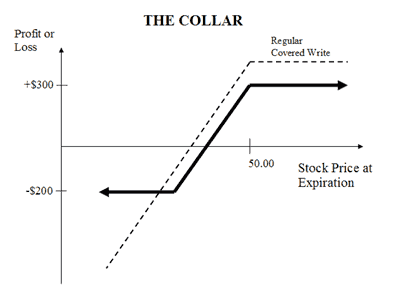Covered calls are a popular way to generate income from an existing stock position, but they aren’t the best choice for every situation. For instance, covered calls have significant downside risk and don’t protect you from large losses or help you lock in profits. Fortunately, there are hundreds of different options strategies out there to help you meet your specific goals.
Let’s take a closer look at the collar option strategy, when you might want to use it and some alternatives to consider that aim to accomplish a similar goal.
What Is a Collar?
Collars, also known as hedge wrappers, are an options strategy designed to protect against large losses, but like a covered call, there’s limited upside potential.
You can create a collar position by purchasing an out-of-the-money put option while simultaneously writing an out-of-the-money call option. The put option protects you in case the stock price drops while the call option generates income to offset the cost of buying the put option. Of course, the call option also limits your upside potential to the strike price.

In the option diagram above, you can see that the downside is limited by the put option’s strike price and the upside is limited by the call option’s strike price.
The breakeven point is equal to the purchase price of the underlying stock plus the net premium paid (or minus the net premium received). The max profit occurs when the price of the underlying stock is greater than or equal to the strike price of the call. The max loss occurs when the price of the underlying stock is less than or equal to the strike price of the put.
Many investors seek to generate enough premium income from selling the call option to pay for the put option. If the position is established at a net-zero cost, or in other words, cost nothing to establish, it’s referred to as a zero-cost collar. Some collar positions can even be established for a net credit if the call is worth more than the put.
Collar Strategy Example
Suppose that you’re holding 100 shares of a stock trading at $50.00 per share in June. You decide to establish a collar by writing (or selling) a JUL 55 covered call for $2.00 while simultaneously purchasing a JUL 45 put for $1.00. The $2.00 covered call offsets the cost of the $1.00 put and leaves you with $100 ($1.00 x 100 shares) in income.
There are three scenarios that may occur:
- The stock price remains between $45.00 and $55.00 and you keep the $100 in premium income.
- The stock price rises above $55.00 and you sell for a $600 profit ($500 + $100 in income).
- The stock price falls below $45.00 and you exit the position for a $400 loss ($500 – $100 in income).
The primary benefit comes if the stock falls sharply below $45.00, in which case, you avoid significant losses thanks to the put option. Of course, the worst-case scenario is that the stock rises sharply higher than $55.00, creating a significant opportunity cost.
When to Use a Collar
Many investors use collar strategies following a significant run-up in the stock price as a way to protect their unrealized gains from a downturn. For instance, suppose that you’re holding a tech stock that rallies sharply higher and well beyond a reasonable valuation. You don’t necessarily want to sell because you’re a long-term believer in the stock and want to avoid a high tax rate, but you may want to limit the potential downside risk.
If you have an existing covered call position, you can also turn it into a collar by purchasing an out-of-the-money put. You can avoid selling the underlying stock—potentially generating high-tax gains—and instead mitigate the risk with a short-term option. The strategy can be particularly useful during high-risk events, such as earnings or other predictable market-moving announcements. It’s a great addition to a wider covered call strategy.
Traders may also use collars on their own when they have a moderately bullish stance. While the capital outlay required lowers the return potential, the strategy is a lower risk version of a bull call spread that enables them to profit from moderately bullish movements. The strategy is essentially a lower risk, lower return version of a covered call strategy. Traders can also adjust the risk of the strategy by adjusting the out-of-the-money or time ranges.
Alternatives to Consider
There are several other bullish strategies that limit risk, including bull put spreads and bull call spreads. These strategies have a similar risk profile in that they have capped upside and downside risk, but unlike collars, they don’t require the purchase of underlying stock and thereby increase leverage on the position.

For long-term investors, there are few options strategies that are comparable to collars. Covered calls can help mitigate risk by offsetting some downside with the premium income, but you’re still exposed to downside risk. Purchasing puts are a good way to protect your long stock positions against a significant decline in price.
The Bottom Line
Collars are an options strategy that enables you to protect your stock from significant downside while retaining upside potential. If you’re using covered calls, you may want to consider converting it into a collar if you’re concerned about significant downside risk. Collars are ideal to utilize when shareholders have a short-term bearish outlook. Consistent use of a collar position will leave investors treading water.
You can also reduce the risk of covered call positions by intelligently picking the underlying stock portfolio. The Snider Investment Method is designed to help investors minimize risk and maximize returns by picking high-quality stocks with significant income potential.




